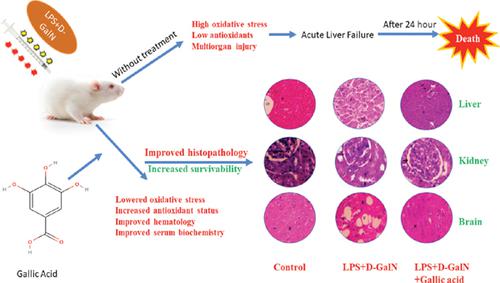Current Pharmaceutical Biotechnology ( IF 2.2 ) Pub Date : 2020-10-31 , DOI: 10.2174/1389201021666200615165732 Samrat Rakshit 1 , Satendra K Nirala 2 , Monika Bhadauria 1

|
Background: Secondary metabolites of plants, the polyphenols, play a vital role in protection from many health problems in human beings. Structurally favored phytochemicals may be studied to protect multiorgan injury. At pharmacological doses, gallic acid is nontoxic to mammals and is generally absorbed in the intestine.
Aims: In this present study, gallic acid was evaluated for its protective efficacy against Lipo Polysaccharide (LPS) and d-Galactosamine (D-GalN) induced multiorgan injury, i.e., liver, kidney and brain.
Methods: Three different doses of gallic acid (5, 10 and 20 mg/kg p.o.) were administered to the experimental animals for 6 consecutive days, followed by exposure to LPS (50 μg/kg I.P.) and D-GalN (300 mg/kg I.P.) on the 6th day.
Results: Exposure to LPS and D-GalN resulted in increased oxidative stress and proinflammatory cytokines. Altered hematology and serology due to LPS and D-GalN were restored towards control by gallic acid. Declined antioxidants such as reduced glutathione, superoxide dismutase and catalase due to injurious effects of LPS and D-GalN were rejuvenated by gallic acid.
Discussion: Exposure to LPS and D-GalN severely increased lipid peroxidation, CYP2E1 activity and tissue lipids while lowered protein content. Gallic acid restored all these parameters towards control in dose dependent manner and 20 mg/kg dose provided the best protection. Histological study showed improved histoarchitecture of liver, kidney and brain that supported biochemical endpoints.
Conclusion: Gallic acid minimized oxidative stress and provided best protection at 20 mg/kg dose against LPS and D-GalN induced multi organ acute injury.
中文翻译:

没食子酸可防止脂多糖和 D-半乳糖胺引起的急性多器官损伤。
背景:植物的次级代谢产物多酚在保护人类免受许多健康问题方面起着至关重要的作用。可以研究结构上有利的植物化学物质以保护多器官损伤。在药理剂量下,没食子酸对哺乳动物无毒,通常在肠道中被吸收。
目的:在本研究中,评估了没食子酸对脂多糖 (LPS) 和 d-半乳糖胺 (D-GalN) 诱导的多器官损伤,即肝、肾和脑的保护功效。
方法:连续 6 天向实验动物施用三种不同剂量的没食子酸(5、10 和 20 mg/kg po),然后暴露于 LPS(50 μg/kg IP)和 D-GalN(300 mg/kg)。 kg IP)在第 6 天。
结果:暴露于 LPS 和 D-GalN 导致氧化应激和促炎细胞因子增加。由 LPS 和 D-GalN 引起的血液学和血清学改变通过没食子酸恢复控制。没食子酸使由于 LPS 和 D-GalN 的有害作用而下降的抗氧化剂如还原型谷胱甘肽、超氧化物歧化酶和过氧化氢酶恢复活力。
讨论:暴露于 LPS 和 D-GalN 会严重增加脂质过氧化、CYP2E1 活性和组织脂质,同时降低蛋白质含量。没食子酸以剂量依赖性方式将所有这些参数恢复到控制,20 mg/kg 剂量提供了最好的保护。组织学研究表明,肝脏、肾脏和大脑的组织结构得到改善,支持生化终点。
结论:没食子酸使氧化应激最小化,并在 20 mg/kg 剂量下对 LPS 和 D-GalN 诱导的多器官急性损伤提供最佳保护。











































 京公网安备 11010802027423号
京公网安备 11010802027423号